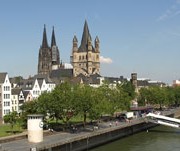Here’s our pick of the top ten free things to do during a visit to the city:
1. Go to see Checkpoint Charlie
When the East and West were divided, Checkpoint Charlie was the name given to the manned crossing point where you could officially pass from one side to the other. Although the wall came down in November 1989, the checkpoint remained an official crossing for foreigners and diplomats until German reunification in October 1990, when the guard house was removed. A copy of the guard house and sign that once marked the border crossing now stands where Checkpoint Charlie once was, and serves as a great indicator of how life was during the Cold War era.
2. Take a stroll around Potsdamer Platz
Lying about one kilometre south of the Brandenburg Gate, Potsdamer Platz is a public square where the old road from Potsdam passed through the city wall of Berlin at the Potsdam Gate. Throughout the cold war it was left as wasteland, but since reunification, has been extensively re-developed. These days it consists of three developments known as Daimler City or the DaimlerChrysler Areal, the Sony Centre and the Beisheim Centre.
3. Take a free walking tour of Berlin
A great way to learn about Berlin and its history is to join this free tour. It begins at Starbucks Cafe on Unter den Linden and takes in all the sights within the area, including the Brandenburg Gate, Checkpoint Charlie, and more. Start times are 11am, 1pm and 4pm every day.
4. Make the most of ‘free admission Sundays’
On the first Sunday of every month, tourists can take advantage of free admission to all the state museums, including the Pergamon, Alte Nationalgalerie, Altes Museum, Ägyptisches Museum, Gemäldegalerie, Neue Nationalgalerie, Sammlung Berggruen, and the Museum for Gegenwart. You’ll have to be prepared for crowds, but it’s a fantastic opportunity to see some of Berlin’s best museums.
5. Visit the Reichstag and the Brandenburg Gate
Germany’s impressive Parliament building, the Reichstag, is well worth a visit. Entry is free, and you can wander round on your own, as there are no guided tours on offer. Climbing to the top of the glass dome will give you some great views of the city, and the exhibition of black-and-white photos portraying the history of the Reichstag since its birth in 1894 is fascinating. Once you’ve taken a look around the Reichstag, you should head to the nearby Brandenburg Gate and take a photograph of Berlin’s most iconic structure.
6. Walk around the Holocaust Memorial
This might not sound like an especially uplifting thing to do during a visit to Berlin, but the Holocaust Memorial is definitely worth visiting during your stay. Although horrific, the holocaust is nevertheless an important part of recent European history to learn about, and the information centre under the memorial will allow you to do just that. The memorial itself though is worth seeing quite in its own right – opened in May 2005, it occupies a huge site just south of the Brandenburg Gate, and is made up of more than 2,700 giant concrete slabs. It’s a very unique sight to behold and has attracted more than a little controversy over the years. Designed by architect Peter Eisenman, it is intended to produce an uneasy, confusing atmosphere and represents a ‘supposedly ordered system that has lost touch with human reason’.
7. Take a look around the Volkswagen showroom
Of course, this won’t be everyone’s cup of tea, but for any car lovers it’s an absolute must. Located on Friedrichstrasse at the corner of Unter den Linden and spread over three floors, the VW showroom contains every type of car under the Volkswagen brand for you to see. In the basement, you can also find information on the developments in space travel which the company has been involved in.
8. Explore the Eastside Gallery
Showcasing 1.3km of undisturbed Berlin Wall, the Eastside Gallery contains more than a hundred pieces of art – all painted directly onto the Wall. The gallery is open-air, so not one for a rainy day, but it’s definitely worth a look.
9. Walk around the Treptower Park
Located in former East Berlin, this massive park’s central area is dominated by the huge 1949 Soviet Memorial. Treptower Park’s burial ground is said to contain the remains of five thousand soldiers who died in the Battle of Berlin, and is lined by marble sculptures depicting scenes from the war.
Berlin actually has a lot of parks and green areas to enjoy, all of which are free.
10. Head out to the Berlin hinterland
Admittedly, this may cost you a small train or bus fare, but once you arrive at the hinterland you can enjoy all that nature has to offer for free. Consisting of forests, lakes and beaches, the hinterland has long been popular with city dwellers who want to soak up some country air and enjoy the Great Outdoors.
Currently, Cactus works with two German schools in Berlin, each offering a range of courses at a variety of levels. Included in the course offerings are General, Intensive and Individual German, and the more specialist options of Teacher Refresher courses, Juniors course and Christmas/Advent courses. Find out more on the Cactus Language website.


